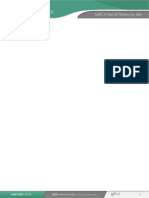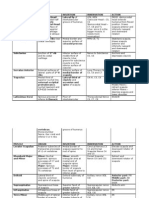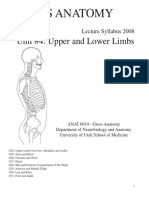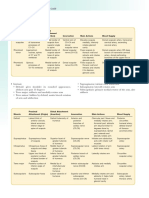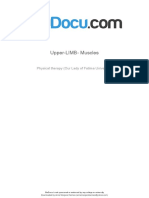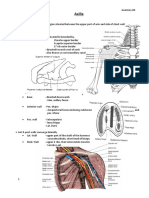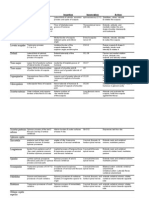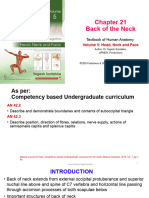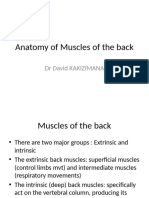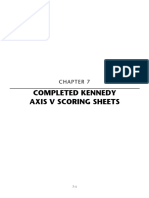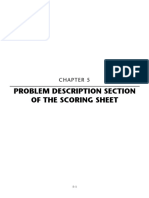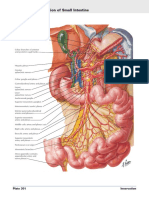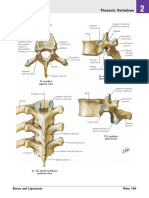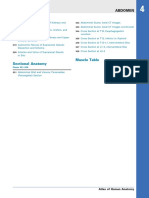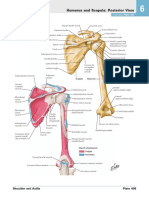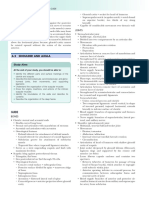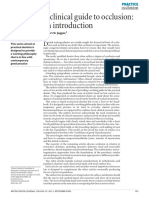0 ratings0% found this document useful (0 votes)
63 viewsBack and Spinal Cord Study Guide: 2.1 Topographic Anatomy Study Aims
Back and Spinal Cord Study Guide: 2.1 Topographic Anatomy Study Aims
Uploaded by
MihaelaThis document provides a study guide for the back and spinal cord, including:
- Key structures and their vertebral level associations, such as the mandible being at C2-C3 and the iliac crests at L4.
- Landmarks of the back like the posteromedian furrow and vertebra prominens.
- Details on performing lumbar puncture between the L3-L4 or L4-L5 vertebrae to access the spinal fluid while avoiding the spinal cord.
- A reminder that the relevant muscles of the back are covered in another section.
Copyright:
© All Rights Reserved
Available Formats
Download as PDF, TXT or read online from Scribd
Back and Spinal Cord Study Guide: 2.1 Topographic Anatomy Study Aims
Back and Spinal Cord Study Guide: 2.1 Topographic Anatomy Study Aims
Uploaded by
Mihaela0 ratings0% found this document useful (0 votes)
63 views1 pageThis document provides a study guide for the back and spinal cord, including:
- Key structures and their vertebral level associations, such as the mandible being at C2-C3 and the iliac crests at L4.
- Landmarks of the back like the posteromedian furrow and vertebra prominens.
- Details on performing lumbar puncture between the L3-L4 or L4-L5 vertebrae to access the spinal fluid while avoiding the spinal cord.
- A reminder that the relevant muscles of the back are covered in another section.
Original Description:
anatomie
Original Title
pg_0627
Copyright
© © All Rights Reserved
Available Formats
PDF, TXT or read online from Scribd
Share this document
Did you find this document useful?
Is this content inappropriate?
This document provides a study guide for the back and spinal cord, including:
- Key structures and their vertebral level associations, such as the mandible being at C2-C3 and the iliac crests at L4.
- Landmarks of the back like the posteromedian furrow and vertebra prominens.
- Details on performing lumbar puncture between the L3-L4 or L4-L5 vertebrae to access the spinal fluid while avoiding the spinal cord.
- A reminder that the relevant muscles of the back are covered in another section.
Copyright:
© All Rights Reserved
Available Formats
Download as PDF, TXT or read online from Scribd
Download as pdf or txt
0 ratings0% found this document useful (0 votes)
63 views1 pageBack and Spinal Cord Study Guide: 2.1 Topographic Anatomy Study Aims
Back and Spinal Cord Study Guide: 2.1 Topographic Anatomy Study Aims
Uploaded by
MihaelaThis document provides a study guide for the back and spinal cord, including:
- Key structures and their vertebral level associations, such as the mandible being at C2-C3 and the iliac crests at L4.
- Landmarks of the back like the posteromedian furrow and vertebra prominens.
- Details on performing lumbar puncture between the L3-L4 or L4-L5 vertebrae to access the spinal fluid while avoiding the spinal cord.
- A reminder that the relevant muscles of the back are covered in another section.
Copyright:
© All Rights Reserved
Available Formats
Download as PDF, TXT or read online from Scribd
Download as pdf or txt
You are on page 1of 1
e40
SECTION 2 — Back and Spinal Cord Study Guide
2 Back and Spinal Cord
Study Guide
2.1 TOPOGRAPHIC ANATOMY Vertebrae and Corresponding Structures
Level Corresponding Structure
Study Aims C2–C3 Mandible
C3 Hyoid bone
At the end of your study, you should be able to: C4–C5 Thyroid cartilage
• Identify posteromedian furrow C6 Cricoid cartilage
C7 Vertebra prominens
• Identify external occipital protuberance, vertebra promi-
T3 Spine of scapula
nens, iliac crests, posterior superior iliac spines
T4/5 Sternal angle (of Louis)
• Identify deltoid, latissimus dorsi, trapezius, erector spinae,
T7 Inferior angle of scapula
teres major, infraspinatus, gluteus maximus, and gluteus
T8 Inferior vena cava pierces diaphragm
medius
T10 Xiphisternal junction
• Identify margins of scapula
T10 Esophagus enters stomach
T12 Aorta passes behind diaphragm
L1/2 Spinal cord ends (cauda equina starts)
L3 Subcostal plane
GUIDE L3–L4 Umbilicus
• Median line of back: posteromedian furrow overlies tips L4 Bifurcation of aorta
L4 Iliac crests—supracristal line
of spinous processes
S2 End of dural sac
• Deepest in lower thoracic/upper lumbar region S2 Level of posterior superior iliac spines
• Bordered by erector spinae
• Vertebra prominens = C7 spinous process (T1 may be more
prominent)
• Scapula
• Superior angle at level of T2
• Medial end of scapular spine opposite spinous process CLINICAL POINTS
of T3
• Inferior angle at level of T7 LUMBAR PUNCTURE
• Medial border of scapula parallels sixth rib and approx- Lumbar puncture is performed for retrieval of cerebrospi-
imates oblique fissure of lung when arm is abducted by nal fluid (CSF) from the lumbar spinal cistern. The patient
placing hand on head. is placed in the left decubitus position, flexed in the fetal
• Iliac crests at level of L4 = supracristal line posture with the supracristal line vertical. Puncture should
• S2 spinous process lies level with a line joining posterior be made at the L3/4 (immediately superior) or L4/5
superior iliac spines. (immediately inferior) interspace in the midline of the
• Tip of coccyx approximately 2.5 cm posterosuperior to back, to avoid the spinal cord.
anus
MEMORY AIDS
Anatomy of muscles of the back are covered in Section 2.4,
Muscles and Nerves. (Muscles that are readily visible are tra- Lumbar puncture: To keep the cord alive, keep the needle
pezius, latissimus dorsi, and teres major.) between L3 and L5!
e40
You might also like
- Mo Reda MrcsDocument550 pagesMo Reda MrcsS Muhammad Hashim Raza100% (1)
- Plabverse AllDocument316 pagesPlabverse AllFahad IqbalNo ratings yet
- Meeks MethodDocument13 pagesMeeks Methodmike9and100% (2)
- Hamstring Injury - Diagnosis and Injury Management DiagnosisDocument5 pagesHamstring Injury - Diagnosis and Injury Management Diagnosisgemichan26No ratings yet
- PushPull-UpperLower SplitsDocument8 pagesPushPull-UpperLower SplitsRyan Pan75% (4)
- Annotated OneShotANAT, DR Ashwani 230208 143653 24 240312 114034Document15 pagesAnnotated OneShotANAT, DR Ashwani 230208 143653 24 240312 114034mmt11297No ratings yet
- Back Muscle ChartDocument3 pagesBack Muscle ChartTony Montana100% (1)
- Table of Back Muscles RWDocument3 pagesTable of Back Muscles RWFrank Zhang100% (1)
- 4-brachial plexus & Lumbosacral PlexusDocument27 pages4-brachial plexus & Lumbosacral PlexusAwais IrshadNo ratings yet
- Dr. Syed Irfan Raza ArifDocument27 pagesDr. Syed Irfan Raza ArifSyed Irfan ArifNo ratings yet
- Gross HSB 3.4 ThoraxDocument5 pagesGross HSB 3.4 ThoraxManci Bito-onNo ratings yet
- Lecture 4 Muscles of NeckDocument35 pagesLecture 4 Muscles of Neckfatimanasir2266No ratings yet
- Posterior Thoracoappendicular and Scapulohumeral MusclesDocument2 pagesPosterior Thoracoappendicular and Scapulohumeral MusclesTrisha HaNo ratings yet
- Upper Limb AnatomyDocument7 pagesUpper Limb AnatomybenpriddinNo ratings yet
- Clavicular Head:: RD THDocument3 pagesClavicular Head:: RD THSam PadreNo ratings yet
- Suboccipital and Scapular Region 1125Document50 pagesSuboccipital and Scapular Region 1125qns8mhb7wyNo ratings yet
- Plexopathy and MononeuropathyDocument38 pagesPlexopathy and MononeuropathySOUMYADEEP BHUINYANo ratings yet
- Brachial PlexusDocument35 pagesBrachial Plexusdevanshidutta303No ratings yet
- 02 Posterior Abdominal WallDocument42 pages02 Posterior Abdominal Wallkoromamosesjohn142No ratings yet
- Unit4 DM - Vb.inddDocument31 pagesUnit4 DM - Vb.inddAlexNo ratings yet
- Anatomy Lab #1 (Thoracic walls, lower respiratory tract)Document23 pagesAnatomy Lab #1 (Thoracic walls, lower respiratory tract)alwdrakanNo ratings yet
- Thorax Part One Thoracic WallsDocument54 pagesThorax Part One Thoracic Wallsignatiodominic512No ratings yet
- Spinal_CordDocument67 pagesSpinal_CordEyya ElFaydiNo ratings yet
- 1D-19 GRSANA Reviewer 1.04 - Muscles of The Shoulder RegionDocument16 pages1D-19 GRSANA Reviewer 1.04 - Muscles of The Shoulder RegionShaira Aquino VerzosaNo ratings yet
- Notes - ASE5101Document23 pagesNotes - ASE5101Camila AgostinisNo ratings yet
- Examination of SpineDocument6 pagesExamination of SpineadiNo ratings yet
- Viscero-Somatic Reflex Anterior Point Posterior Point: Chapman's PointsDocument3 pagesViscero-Somatic Reflex Anterior Point Posterior Point: Chapman's PointsEman Elzeftawy100% (1)
- Clavicular Part: Flexes and Acromial Part: AbductsDocument1 pageClavicular Part: Flexes and Acromial Part: AbductsMihaelaNo ratings yet
- 3-Spinal Cord GrossDocument40 pages3-Spinal Cord GrossfeyijinmiNo ratings yet
- 1 - Ribs & Muscles Involved in RespirationDocument10 pages1 - Ribs & Muscles Involved in RespirationjahjathemuslimNo ratings yet
- Anatomy Notes MusclesDocument24 pagesAnatomy Notes Musclesjonmusco100% (1)
- Upper-LIMB-Muscles Upper-LIMB - MusclesDocument8 pagesUpper-LIMB-Muscles Upper-LIMB - MusclesAnne SerneoNo ratings yet
- Anatomy 06 - Axilla (Pre Med 101)Document8 pagesAnatomy 06 - Axilla (Pre Med 101)Navoda Dulshan PereraNo ratings yet
- Board Review For Anatomy: John A. Mcnulty, PH.DDocument7 pagesBoard Review For Anatomy: John A. Mcnulty, PH.Dbob_charlieNo ratings yet
- 3-Spinal Cord Injury IntroductionDocument264 pages3-Spinal Cord Injury Introductionhoorsaeed111No ratings yet
- Muslce Chart GA1Document10 pagesMuslce Chart GA1kaycorkumNo ratings yet
- 2nd Order (Unit I) - ADocument3 pages2nd Order (Unit I) - Auberjunk426801No ratings yet
- Spine: Aggasid Azman Corpuz LagundiDocument59 pagesSpine: Aggasid Azman Corpuz LagundiJho AggasidNo ratings yet
- Chapter 21 Back of The Neck NewDocument63 pagesChapter 21 Back of The Neck NewMohan PalanimalaiNo ratings yet
- Muscles of The BackDocument27 pagesMuscles of The Backkaruranga99No ratings yet
- 09:16 - Back & Spinal Cord PDFDocument24 pages09:16 - Back & Spinal Cord PDFVidya BalaNo ratings yet
- Back Spine AnatomyDocument3 pagesBack Spine AnatomyNinjaNo ratings yet
- 5.1 Spinal Cord AnatomyDocument3 pages5.1 Spinal Cord Anatomyztkwx9z9m6No ratings yet
- Upper Limb 0809 PDFDocument59 pagesUpper Limb 0809 PDFasdaNo ratings yet
- Anatomy All NotesDocument77 pagesAnatomy All NotesBat ManNo ratings yet
- Spinal Cord Injury IntroductionDocument243 pagesSpinal Cord Injury Introductionfahad100% (1)
- ANA211 the Brachial PlexusDocument37 pagesANA211 the Brachial PlexusHenry xoxoNo ratings yet
- Muscle TableDocument14 pagesMuscle TableHenry xoxoNo ratings yet
- MoinaDocument12 pagesMoinacj.tenederoNo ratings yet
- Anatomy Supertable With Pics PDFDocument39 pagesAnatomy Supertable With Pics PDFCla NuvalNo ratings yet
- Anatomy Supertable With Pics PDFDocument39 pagesAnatomy Supertable With Pics PDFCla NuvalNo ratings yet
- Muscles of The BackDocument33 pagesMuscles of The Backtaha makhloufNo ratings yet
- Spinal Cord Gross Anatomy 2Document40 pagesSpinal Cord Gross Anatomy 2Mohamad NasrullohNo ratings yet
- Thorax Musculoskeletal AnatomyDocument23 pagesThorax Musculoskeletal AnatomyNatalie HuiNo ratings yet
- Tabel Gerakan Sendi Di Neck Trunk Upper Amp Lower Extremity PDF FreeDocument30 pagesTabel Gerakan Sendi Di Neck Trunk Upper Amp Lower Extremity PDF FreeIchlasul AkmalNo ratings yet
- An Breast and PectoralisDocument36 pagesAn Breast and PectoralisTom Tsou100% (1)
- Thorax 1Lecture for 1st yearDocument31 pagesThorax 1Lecture for 1st yearShahd HiaryNo ratings yet
- Anatomy - PDF Plab ResourcesDocument12 pagesAnatomy - PDF Plab ResourcesYoumna ShaabanNo ratings yet
- Tabel Gerakan Sendi Di Neck & Trunk, Upper Extremity Dan Lower ExtremityDocument31 pagesTabel Gerakan Sendi Di Neck & Trunk, Upper Extremity Dan Lower Extremityfira fadhillah salyNo ratings yet
- Ana Shoulder RegionDocument10 pagesAna Shoulder RegionVictuuri aNo ratings yet
- PG 0290Document1 pagePG 0290MihaelaNo ratings yet
- J. H. Stonehouse, Malcolm Faulk, Sarah Roberts, - Faulk's Basic Forensic Psychiatry 3rd Edition (1999)Document322 pagesJ. H. Stonehouse, Malcolm Faulk, Sarah Roberts, - Faulk's Basic Forensic Psychiatry 3rd Edition (1999)MihaelaNo ratings yet
- Kennedy Axis VDocument24 pagesKennedy Axis VMihaelaNo ratings yet
- Janofsky 1992Document5 pagesJanofsky 1992MihaelaNo ratings yet
- Kennedy Axis VDocument10 pagesKennedy Axis VMihaelaNo ratings yet
- PG 0394Document1 pagePG 0394MihaelaNo ratings yet
- Vertebral Ligaments: Lumbosacral Region : Left Lateral ViewDocument1 pageVertebral Ligaments: Lumbosacral Region : Left Lateral ViewMihaelaNo ratings yet
- Kennedy Axis VDocument18 pagesKennedy Axis VMihaelaNo ratings yet
- James A. Kennedy - Mastering The Kennedy Axis V - A New Psychiatric Assessment of Patient Functioning (2003) - 1-15Document15 pagesJames A. Kennedy - Mastering The Kennedy Axis V - A New Psychiatric Assessment of Patient Functioning (2003) - 1-15MihaelaNo ratings yet
- PG 258Document1 pagePG 258MihaelaNo ratings yet
- PG 0336Document1 pagePG 0336Mihaela100% (1)
- Thoracic Vertebrae : T6 Vertebra: Superior View T6 Vertebra: Lateral ViewDocument1 pageThoracic Vertebrae : T6 Vertebra: Superior View T6 Vertebra: Lateral ViewMihaelaNo ratings yet
- Atlas of Human Anatomy I-37Document1 pageAtlas of Human Anatomy I-37MihaelaNo ratings yet
- Autonomic Reflex Pathways: Schema : Innervation Plate 304Document1 pageAutonomic Reflex Pathways: Schema : Innervation Plate 304MihaelaNo ratings yet
- Psoas and Iliacus Muscles : See Also Plates 253, 258, 262Document1 pagePsoas and Iliacus Muscles : See Also Plates 253, 258, 262MihaelaNo ratings yet
- PG 0357Document1 pagePG 0357MihaelaNo ratings yet
- Autonomic Nerves in Thorax : Lungs Plate 206Document1 pageAutonomic Nerves in Thorax : Lungs Plate 206MihaelaNo ratings yet
- Sectional Anatomy Muscle Table: AbdomenDocument1 pageSectional Anatomy Muscle Table: AbdomenMihaelaNo ratings yet
- Humerus and Scapula: Posterior View : See Also Plate 183Document1 pageHumerus and Scapula: Posterior View : See Also Plate 183MihaelaNo ratings yet
- PG 0093Document1 pagePG 0093MihaelaNo ratings yet
- PG 0257Document1 pagePG 0257MihaelaNo ratings yet
- Wrist and Hand: Deep Dorsal Dissection : See AlsoDocument1 pageWrist and Hand: Deep Dorsal Dissection : See AlsoMihaelaNo ratings yet
- PG 0471Document1 pagePG 0471MihaelaNo ratings yet
- Clinical Points: at The End of Your Study, You Should Be Able ToDocument1 pageClinical Points: at The End of Your Study, You Should Be Able ToMihaelaNo ratings yet
- Lymphatic Drainage of Breast : See AlsoDocument1 pageLymphatic Drainage of Breast : See AlsoMihaelaNo ratings yet
- Uterus and Adnexa : Posterior ViewDocument1 pageUterus and Adnexa : Posterior ViewMihaelaNo ratings yet
- Bony Framework of Pelvis : Plate 330 Bones and LigamentsDocument1 pageBony Framework of Pelvis : Plate 330 Bones and LigamentsMihaelaNo ratings yet
- PG 0334Document1 pagePG 0334Mihaela100% (1)
- PG 0469Document1 pagePG 0469MihaelaNo ratings yet
- GargoilismDocument14 pagesGargoilismRemus SinorchianNo ratings yet
- Schelet AxialDocument69 pagesSchelet Axialzebubu1No ratings yet
- Lesson 3 Nervous SystemDocument11 pagesLesson 3 Nervous SystemMARY JANE ANGELICA SEVANo ratings yet
- PHK Horse Stance ManualDocument9 pagesPHK Horse Stance Manualbabagazebo100% (2)
- Ijoi Vol 47 NewDocument120 pagesIjoi Vol 47 NewvictorNo ratings yet
- ANATOMY AND PHYSIOLOGY-flashcardsDocument21 pagesANATOMY AND PHYSIOLOGY-flashcardsJohn Wayne PharrNo ratings yet
- Gait & Ambulation 2004Document29 pagesGait & Ambulation 2004Marco Tulio FigueroaNo ratings yet
- CH02 SecuredDocument15 pagesCH02 SecuredTahir BajwaNo ratings yet
- ENT Previous Year Question PapersDocument25 pagesENT Previous Year Question Papersalice dionNo ratings yet
- YOGIC SUKSMA VYAYAMA Dhirendra BrahmacharyaDocument75 pagesYOGIC SUKSMA VYAYAMA Dhirendra Brahmacharyaclodomarko80% (5)
- FilDocument6 pagesFilLadyxyrell Mandahinog ParbaNo ratings yet
- O M W, A, B N, M: Review ArticleDocument6 pagesO M W, A, B N, M: Review ArticleGustavo Anguita ContrerasNo ratings yet
- Respiratory System Test-True or False MCQ: Call - Me - Crush007Document40 pagesRespiratory System Test-True or False MCQ: Call - Me - Crush007امتیاز ہاشم بزنجوNo ratings yet
- A Clinical Guide To Occlusion An IntroductionDocument75 pagesA Clinical Guide To Occlusion An IntroductionAndrei Oana50% (2)
- Changing Position of Helpless Patient: Sushmita Kaldan B.SC Nursing 4 Yr 2009 Batch BpkihsDocument50 pagesChanging Position of Helpless Patient: Sushmita Kaldan B.SC Nursing 4 Yr 2009 Batch BpkihsSushmita Kaldan100% (4)
- NCM 101 Health Assessment The Eyes: Prepared byDocument28 pagesNCM 101 Health Assessment The Eyes: Prepared byNicole NipasNo ratings yet
- COMPARATIVE ANATOMY OF FROG AND HUMANnnDocument107 pagesCOMPARATIVE ANATOMY OF FROG AND HUMANnnVic FranciscoNo ratings yet
- Circulatory TestDocument7 pagesCirculatory TestgarnetNo ratings yet
- Respiratory System...Document145 pagesRespiratory System...Cheghe PerezNo ratings yet
- LatarjetDocument7 pagesLatarjetsleonNo ratings yet
- Squat 100 Bench 100 Deadlift 100: Enter Your Maxes HereDocument17 pagesSquat 100 Bench 100 Deadlift 100: Enter Your Maxes HereBenton JavanovichNo ratings yet
- Laporan Praktikum Struktur Hewan Jaringan SarafDocument12 pagesLaporan Praktikum Struktur Hewan Jaringan SarafRezky AmaliahNo ratings yet
- Kelompok: 2 1. Sephia Ananda Sukma 2. Shelly Tira Maulida 3. Siti Stuwaibah AslamiyyahDocument3 pagesKelompok: 2 1. Sephia Ananda Sukma 2. Shelly Tira Maulida 3. Siti Stuwaibah AslamiyyahSephia Ananda SukmanaNo ratings yet
- Proprioceptive Neuromuscular Facilitation Laboratory Guide: Manual Contacts TractionDocument5 pagesProprioceptive Neuromuscular Facilitation Laboratory Guide: Manual Contacts TractionJandie SagaynoNo ratings yet
- Animals Circulatory SystemDocument13 pagesAnimals Circulatory SystemBobong blyatNo ratings yet
- MCN Reviewer 12 23Document48 pagesMCN Reviewer 12 23Ella RetizaNo ratings yet
- Trabajo de Santiago ArrietaDocument3 pagesTrabajo de Santiago ArrietaSantiago ArrietaNo ratings yet
